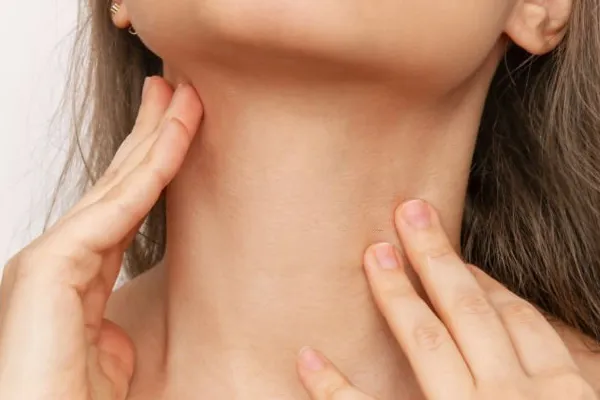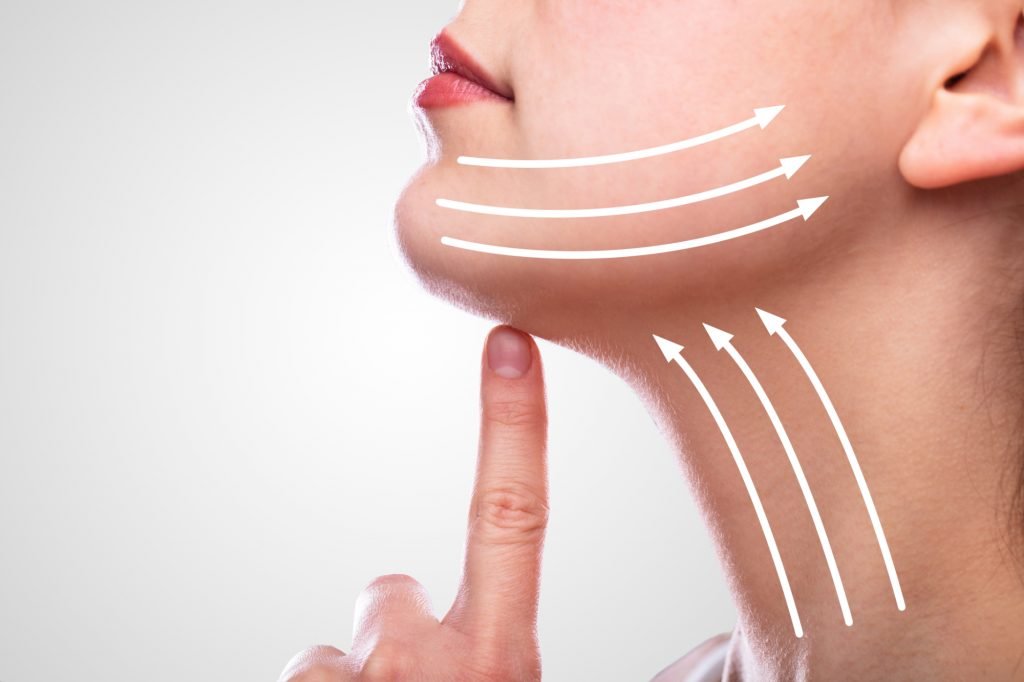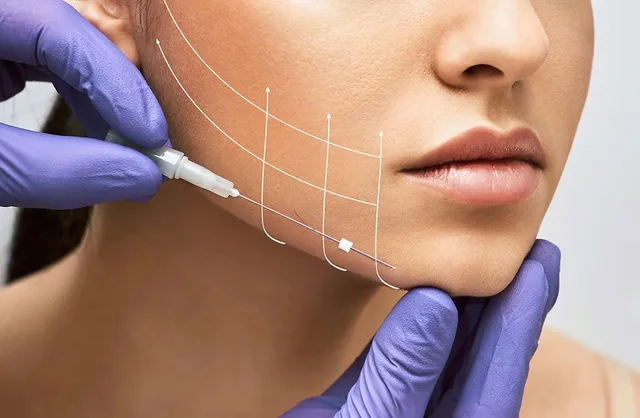A neck thread lift, also known as a thread lift or a non-surgical neck lift, is a cosmetic procedure designed to tighten and lift the skin of the neck and jawline without the need for surgery. It is a minimally invasive procedure that involves the use of specialized threads or sutures to lift sagging or loose skin.
During a neck thread lift, the cosmetic surgeon or dermatologist will insert thin, dissolvable threads beneath the skin through small incisions or entry points. These threads are typically made of biocompatible materials such as polydioxanone (PDO) or polylactic acid (PLLA). Once the threads are in place, they can be carefully adjusted to lift and reposition the skin.
The threads used in a neck thread lift have small cones, hooks, or barbs that provide traction and hold the skin in an elevated position. This creates a subtle lifting effect, reducing the appearance of sagging skin and improving the contour of the neck and jawline.
In addition to the lifting effect, the threads stimulate collagen production in the treated area. Collagen is a protein that helps maintain skin elasticity and firmness. By promoting collagen synthesis, the thread lift can improve the overall texture and quality of the skin over time.
Neck thread lifts are typically performed under local anesthesia, and the procedure can take around 30 minutes to an hour, depending on the extent of the treatment. The recovery time is generally shorter compared to traditional surgical neck lifts, and most individuals can resume their normal activities within a few days.
It’s important to note that the effectiveness and longevity of the results can vary from person to person. The effects of a neck thread lift typically last for around 1 to 2 years, after which the threads are naturally absorbed by the body. Some individuals may choose to undergo additional treatments to maintain the desired results.
As with any cosmetic procedure, it is crucial to consult with a qualified and experienced professional to determine if a neck thread lift is suitable for your specific needs and expectations. They can assess your individual case, discuss the potential risks and benefits, and provide personalized recommendations.

Table of Contents
PDO neck thread lift
A PDO neck thread lift is a specific type of neck thread lift that utilizes threads made of polydioxanone (PDO). Polydioxanone is a biocompatible material that has been used in various medical applications, including surgical sutures.
In a PDO neck thread lift procedure, the cosmetic surgeon or dermatologist will insert PDO threads beneath the skin of the neck through small incisions or entry points. These threads have small barbs or cones that provide traction and hold the skin in an elevated position, creating a lifting effect.
Once the threads are in place, they stimulate collagen production in the treated area. Collagen is a protein that helps maintain skin elasticity and firmness. Over time, the production of new collagen can improve the texture and quality of the skin, contributing to a rejuvenated and lifted appearance.
PDO threads are absorbable, meaning that they are gradually broken down by the body over time. As the threads dissolve, they stimulate additional collagen synthesis, which helps to maintain the results of the procedure. The effects of a PDO neck thread lift typically last for around 1 to 2 years, but individual results may vary.
PDO neck thread lifts are typically performed under local anesthesia, and the procedure itself can take around 30 minutes to an hour, depending on the extent of the treatment. Recovery time is generally shorter compared to traditional surgical neck lifts, and most individuals can resume their normal activities within a few days.
As with any cosmetic procedure, it is important to consult with a qualified and experienced professional to determine if a PDO neck thread lift is suitable for your specific needs. They can assess your individual case, discuss the potential risks and benefits, and provide personalized recommendations based on your desired outcomes.
barbed thread neck lift
A barbed thread neck lift, also known as a barbed suture or barbed thread lift, is a type of non-surgical procedure used to lift and tighten sagging skin in the neck and jawline area. It is a minimally invasive alternative to traditional surgical neck lifts.
During a barbed thread neck lift, the cosmetic surgeon or dermatologist uses specialized sutures or threads that have tiny barbs or hooks along their length. These barbs allow the threads to grab onto the skin and soft tissues, providing a lifting effect when the threads are pulled.
The procedure typically begins with the administration of local anesthesia to numb the treatment area. Then, small incisions or entry points are made in the skin, and the barbed threads are inserted beneath the skin using a fine needle or cannula.
Once the threads are in place, they are carefully adjusted and tensioned to lift and reposition the sagging skin. The barbs on the threads engage with the tissue, anchoring the lifted position.
In addition to the immediate lifting effect, the barbed threads stimulate collagen production in the treated area. Collagen is a protein that helps maintain skin elasticity and firmness. By promoting collagen synthesis, the procedure can lead to further improvements in skin quality over time.
The barbed thread neck lift procedure is typically performed on an outpatient basis, and the duration can vary depending on the extent of the treatment. Recovery time is generally shorter compared to traditional surgical neck lifts, and most individuals can resume their normal activities within a few days.
It’s important to note that the effectiveness and longevity of the results can vary from person to person. The effects of a barbed thread neck lift typically last for around 1 to 2 years, after which the threads are gradually absorbed by the body. Some individuals may choose to undergo additional treatments to maintain or enhance the results.
As with any cosmetic procedure, it is crucial to consult with a qualified and experienced professional to determine if a barbed thread neck lift is suitable for your specific needs. They can assess your individual case, discuss the potential risks and benefits, and provide personalized recommendations based on your desired outcomes.

Benefits of thread neck lift
A thread neck lift, whether using PDO threads or barbed threads, offers several potential benefits compared to traditional surgical neck lifts or other invasive procedures. Some of the benefits include:
- Non-surgical and minimally invasive: A thread neck lift is a non-surgical procedure that avoids the need for large incisions or extensive surgical interventions. It is performed using small entry points, resulting in minimal scarring and reduced risk of complications associated with surgery.
- Quick procedure with minimal downtime: The thread neck lift procedure typically takes a shorter time to perform compared to surgical neck lifts. It is often done as an outpatient procedure, and most individuals can resume their normal activities within a few days, making it a convenient option for those with busy lifestyles.
- Natural-looking results: The threads used in a neck lift procedure are designed to lift and reposition the skin in a way that appears natural. They provide subtle and gradual improvements, resulting in a rejuvenated and lifted appearance without the “over-pulled” or “stretched” look that can sometimes occur with surgical procedures.
- Collagen stimulation and skin rejuvenation: One of the advantages of thread neck lifts is that they stimulate collagen production in the treated area. The threads promote the natural production of collagen, a protein that helps maintain skin elasticity and firmness. This can lead to improved skin texture, tone, and overall rejuvenation.
- Versatility and customization: Thread neck lifts can be customized to address specific concerns and individual needs. The threads can be placed in strategic locations to target sagging skin, jowls, or other areas of concern. The procedure can be tailored to achieve the desired lift and contour for each patient.
- Lower risk and complications: Compared to surgical procedures, thread neck lifts generally have a lower risk of complications. The procedure is minimally invasive, reducing the risk of infection, scarring, and other surgical risks. However, it is important to note that all procedures carry some level of risk, and it is essential to consult with a qualified professional and follow post-procedure care instructions.
It is important to keep in mind that the effectiveness and longevity of the results can vary from person to person. The benefits of a neck thread lift are dependent on factors such as the individual’s skin condition, age, and lifestyle. Consulting with a qualified professional is crucial to determine if a thread neck lift is suitable for your specific needs and expectations.
Risks of neck thread lift
While neck thread lifts are generally considered safe and have a lower risk profile compared to surgical procedures, it’s important to be aware of potential risks and complications. These can include:
- Infection: Although rare, there is a small risk of infection at the entry points where the threads are inserted. It’s important to follow proper post-procedure care instructions and keep the treated area clean to minimize this risk.
- Bruising and swelling: Some degree of bruising and swelling is common after a neck thread lift. These side effects are usually temporary and resolve on their own within a few days or weeks.
- Thread migration or visibility: In some cases, the threads used in the procedure may migrate or become visible under the skin. This can result in discomfort or an unnatural appearance. It’s important to choose a skilled and experienced professional to minimize the risk of such complications.
- Thread breakage: Although rare, it is possible for the threads to break. This can occur if excessive force is applied to the treated area or if the threads are not properly placed. Broken threads may require additional procedures to address.
- Nerve or blood vessel injury: There is a small risk of unintentional injury to nerves or blood vessels during the thread insertion process. This can lead to temporary or, in rare cases, permanent numbness, tingling, or other sensory changes in the treated area.
- Allergic reactions or sensitivities: While uncommon, some individuals may experience allergic reactions or sensitivities to the materials used in the threads. It’s important to inform your healthcare provider of any known allergies or sensitivities prior to the procedure.
- Unsatisfactory results: The effectiveness and longevity of the results can vary from person to person. While many individuals are satisfied with the outcomes of a neck thread lift, it’s possible that the desired lift and contour may not be achieved or may not last as long as expected.
It’s essential to consult with a qualified and experienced professional who can assess your individual case, discuss the potential risks and benefits, and provide personalized recommendations based on your specific needs and expectations. They can help you understand the potential risks involved and determine if a neck thread lift is the right procedure for you.

neck thread lift after care
Aftercare following a neck thread lift is crucial for proper healing and optimal results. While specific instructions may vary depending on your healthcare provider and the details of your procedure, here are some general guidelines to follow:
- Follow post-procedure instructions: Carefully adhere to the instructions provided by your healthcare provider. They may include guidelines on wound care, activity restrictions, and medication use. Make sure to ask any questions you may have and seek clarification if needed.
- Keep the treated area clean: Gently cleanse the treated area as instructed by your healthcare provider. Use a mild, non-irritating cleanser and avoid rubbing or scrubbing the area. Pat the skin dry with a clean towel or allow it to air dry.
- Avoid excessive touching or pressure: Minimize touching or putting unnecessary pressure on the treated area. This includes avoiding activities such as rubbing, scratching, or massaging the area. Be cautious when sleeping to avoid putting direct pressure on the treated area.
- Limit strenuous activities: Engage in light activities for the first few days after the procedure and gradually increase your activity level as advised by your healthcare provider. Avoid strenuous exercises, heavy lifting, or activities that may strain the treated area.
- Avoid excessive sun exposure: Protect the treated area from excessive sun exposure. Use a broad-spectrum sunscreen with a high SPF and wear protective clothing, such as a wide-brimmed hat, when going outdoors. Sun protection helps prevent pigmentation changes and supports the healing process.
- Manage discomfort or swelling: It is common to experience some discomfort, swelling, or bruising after a neck thread lift. Your healthcare provider may recommend over-the-counter pain relievers or prescribe medication to help manage any discomfort. Applying cold compresses or ice packs to the area can also help reduce swelling.
- Attend follow-up appointments: Attend all scheduled follow-up appointments with your healthcare provider. These visits are essential for monitoring your progress, assessing the healing process, and addressing any concerns or questions you may have.
- Be patient and realistic: Keep in mind that the results of a neck thread lift take time to fully manifest. It may take a few weeks for any swelling or bruising to subside and for the threads to settle into their desired position. Be patient and maintain realistic expectations regarding the outcome of the procedure.
Always consult your healthcare provider for personalized guidance on post-care instructions specific to your situation. They will provide you with detailed aftercare instructions based on their expertise and your individual needs.
neck thread lift recovery time
The recovery time following a neck thread lift can vary from person to person, and it depends on several factors, including the individual’s healing ability, the extent of the procedure, and the specific techniques used. While recovery experiences may differ, here’s a general timeline of what you can expect:
Immediately after the procedure: You may experience some mild discomfort, swelling, bruising, and tightness in the treated area. Your healthcare provider may provide pain medication or recommend over-the-counter pain relievers to manage any discomfort. You might also be advised to apply cold compresses to help reduce swelling.
First few days: It is common for swelling and bruising to peak within the first few days following the procedure. You may need to limit physical activity, avoid strenuous exercise, and refrain from activities that could strain the treated area. Your healthcare provider may provide specific instructions on sleep positions and any restrictions on neck movement.
First week: Most individuals can typically resume their normal activities within a week after the procedure. However, it’s important to avoid vigorous activities, heavy lifting, and any activities that may strain the treated area. You may still have some residual swelling and bruising, but it should gradually improve over time.
First few weeks: Swelling and bruising should continue to subside during this time. You may notice that the threads start to settle into their desired position, and any initial tightness or discomfort should lessen. However, it’s important to follow the aftercare instructions provided by your healthcare provider and avoid exposing the treated area to excessive sun exposure.
Long-term recovery: While you may be able to resume most of your normal activities within a week or so, it can take several weeks or even a few months for the full results of the neck thread lift to become apparent. During this time, collagen production is stimulated, leading to further skin improvement and tightening. It’s important to maintain regular follow-up appointments with your healthcare provider to monitor your progress and address any concerns.
It’s important to note that recovery times can vary, and individual experiences may differ. Following the specific aftercare instructions provided by your healthcare provider is crucial for a smooth recovery and optimal results. If you have any concerns during your recovery period, it’s best to reach out to your healthcare provider for guidance and support.


